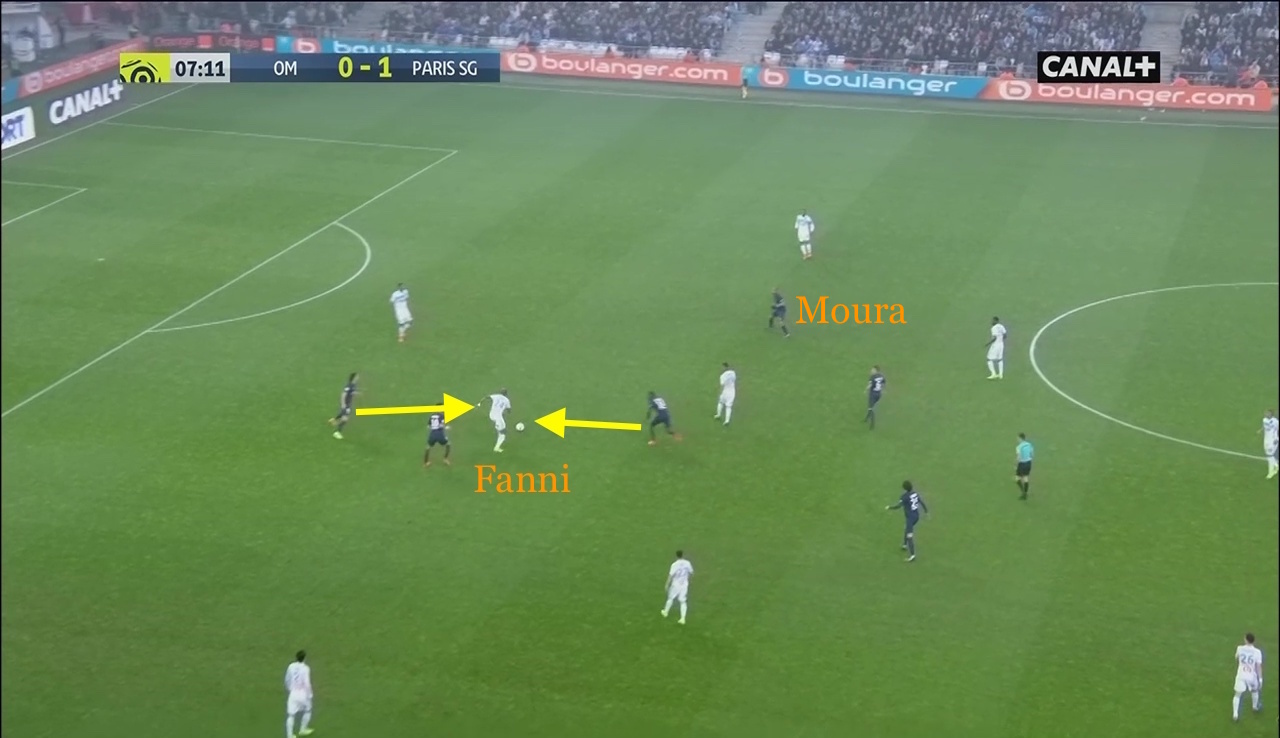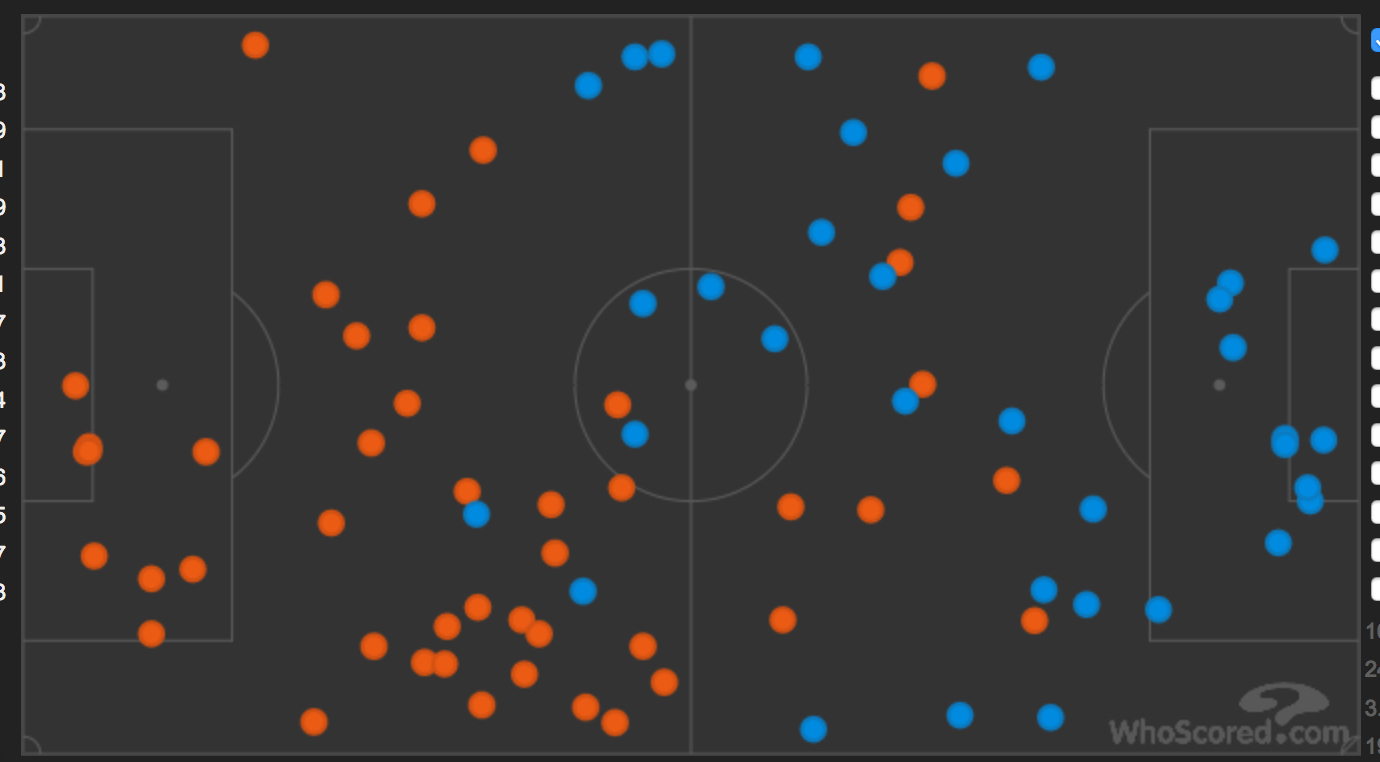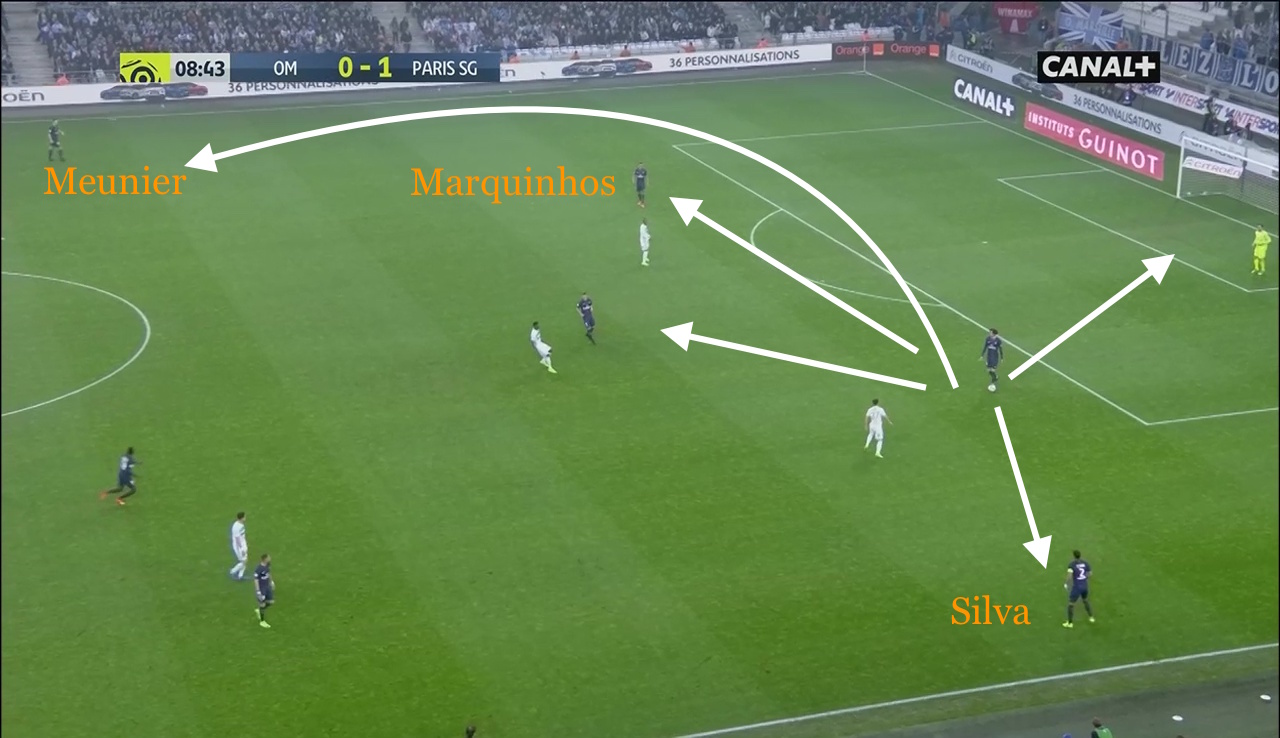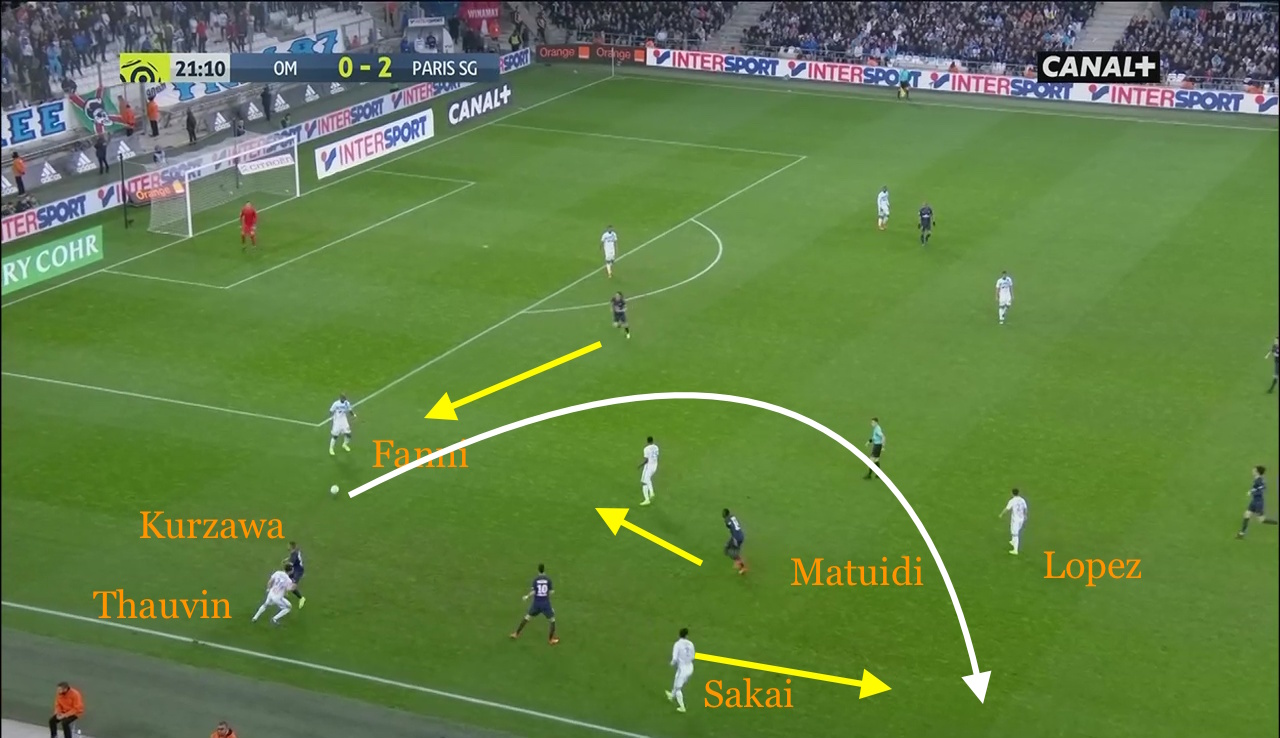Eric Devin writes a detailed tactical analysis of the Ligue 1 match that ended Marsielle 1-5 PSG.
Another encounter with one of France’s top teams, another home loss. Marseille have certainly made progress under Rudi Garcia, especially in comparison to the team’s performances under Michel and Franck Passi last season, but being able to go toe-to-toe with Ligue 1’s elite remains an elusive goal, if Sunday’s visit from Paris Saint-Germain is anything on which to evaluate the team. A sold-out Velodrome crowd were well up for the occasion, billed in France as Le Classique, but were sorely disappointed as the methodical visitors won 5-1, despite not having their first choice eleven available in the absences of Angel Di Maria and Julian Draxler.
However, rather than a takedown of a rebuilding Marseille, this piece should instead illustrate the potential of a Paris Saint-Germain who are perhaps yet to reach their best, this result and their 4-0 takedown of Barcelona notwithstanding. Rather than just play their standard brand of possession-oriented football, the champions instead played more compactly, pressing high and narrow to pin back Marseille’s attack-minded fullbacks and capitalize on the lack of a box-to-box presence of the likes of Morgan Sanson. Marseille were forced to come deeper and deeper for the ball, which made for an uncomfortable evening for the hosts, themselves so accustomed to dominating possession.
Line Ups

Made using TacticalPad
Olympique de Marseille (4-3-3): Yohann Pelé; Hiroki Sakai, Rod Fanni, Rolando, Patrice Evra (Henri Bedimo 46′); Maxime Lopez, William Vainqueur, André-Frank Zambo Anguissa; Florian Thauvin (Gregory Sertic 67′), Clinton N’Jie (Rémy Cabella 52′), Dimitri Payet
Paris Saint-Germain (4-3-3): Kevin Trapp; Thomas Meunier, Marquinhos, Thiago Silva, Layvin Kurzawa; Marco Verratti, Adrien Rabiot, Blaise Matuidi; Lucas Moura (Angel Di Maria 74′), Edinson Cavani (Hatem Ben Arfa 82′), Javier Pastoré (Julian Draxler 55′)


Here we see PSG’s aforementioned initial gambit, which is more often deployed against similarly high-level teams, but was used against Marseille as a counterweight for their possession-based football. Edinson Cavani is the furthest forward of the team, while behind him, the nominal wingers Pastoré and Moura tuck inside. The two wide forwards are given to move inside with regularity in any event, but usually to provide space for overlapping runs by the fullbacks. Here, though, their positions aid the midfield’s pressure, eliminating Marseille’s fullbacks as outlets, with Moura marking Evra.
More centrally, the three midfielders pressure Payet (with ball), who has been forced to drop deep to get the ball. In the absence of Morgan Sanson, whose dynamic, shuttling runs have been so key to both Montpellier and Marseille this season, Marseille’s creative players had to come deep to receive the ball from their teammates. Even if they could retain possession against PSG’s press, there would seldom be players ahead of them as outlet to develop an attack, particularly on the left, where Patrice Evra is far from fleet of foot. Thus, without overlapping fullbacks (admittedly Hiroki Sakai was better in this regard than Evra), Marseille’s creative players, Lopez, Thauvin and Payet, had to bear the brunt of controlling the team’s attacking play. The way to combat pressure like this would normally be to play short, controlled, passes, hoping for an over-eager challenge from the opposition, but that’s not particularly the style of Marseille’s midfielders, who also suffered from a physical disadvantage against their counterparts.
As previously mentioned, Evra isn’t the quickest outlet in terms of being an attack-minded fullback, but Sakai provides some counterpoint to that, the Japanese international often being guilty of neglecting his defensive duties in the service of being an auxiliary attacker. On the night, though, he generally displayed good positional discipline, if not a high level of one-on-one defending, but as the second image shows, that was often to Marseille’s detriment. Here, Sakai has tucked in, naturally, as Pastoré has moved infield to make a run towards goal. However, this infrequent demonstration of good positional intelligence has left Kurzawa, always a threat with his pace and direct style of play, in acres of space.
On the opposite flank, things are little better. Patrice Evra has come into midfield to challenge Lucas Moura on the ball, to little effect. This has, in turn, forced Thauvin deep to deal with the run of Meunier. With Zambo Anguissa having joined Evra in pressing Lucas and Payet dropping deep to aid the press centrally, Marseille have thus committed every outfield player save N’Jie in defense, while PSG have kept their center backs and Rabiot deep to guard against the counter. There is no implication here that Sakai is being derelict in his duties, only an emphasis on how compact Marseille were forced to play under duress.


When the hosts did play in more natural positions, particularly the attackers, this pair of images does well to illustrate the perils of doing so vis-a-vis the positional flexibility of Pastoré and Moura. Neither are known for their defensive work ethic, although Pastoré did show himself to be a capable box-to-box midfielder when called upon under Laurent Blanc. Moura has enjoyed even less of a reputation, but his play under Unai Emery is much improved in this regard, and these images show why Marseille had such difficulties reacting to the fluidity of PSG’s system.
In the first, Maxime Lopez has come forward with the ball on the right flank, with Sakai in support and Thauvin ahead of him. Layvin Kurzawa has taken a somewhat risky proposition in coming towards the teenage playmaker, given Thauvin has advanced past him. However, Pastoré has dropped deep, thus providing cover for the left back; with Sakai lacking the space to make an overlapping run, Marseille’s right side, likely their most dangerous given the former Hannover man’s direct style and the form of Thauvin, is thus nullified. Kurzawa is even given a lane to break upfield (yellow arrow) should he recover the ball, giving the visitors a chance to attack on the counter.
The second image shows the two wide players’ lateral flexibility, which also did much to pin back the Marseille attack. In the absence of a number ten in PSG’s 4-3-3, all three midfielders being decidedly box-to-box players, Moura often functions as the team’s creative conduit, cutting inside to occupy the space that an attacking midfielder might. Not only does this give PSG a different look in attack but it also allows the right back to play on the overlap, no small matter when those right backs are of the quality of Meunier and Serge Aurier. Here, though, Pastoré has also come inside, and as Moura draws a double team from Vainqueur and Zambo Anguissa, there is thus space freed for Matuidi through the middle, or for the Argentine to peel wide (yellow arrows), as Sakai has come inside to aid Fanni in doubling Cavani.


Continuing on the theme of Pastoré and Moura moving inside, there were also benefits to PSG’s defensive play, namely their press. Here, Pastoré and Matuidi have moved to double Fanni (yellow arrows) on the ball, while Moura has likewise tucked in to cut off a switch of play to Evra. This does leave Sakai in space on the near side, but instead of playing the ball along the ground to either fullback, Fanni more often resorted to pumping the ball long. The second image shows the number of long passes that Marseille played, and there is a marked concentration on the right side of the pitch, speaking of how the team persisted in trying to utilize that side of the pitch, but inefficiently.
If Sakai, for all his pace, is playing deep, essentially next to Fanni, he can’t be an outlet for a ball over the top. Thauvin and Lopez, for their part, aren’t exactly slow, but are never favorites against Kurzawa in a foot race. N’Jie does offer that sort of pace, but his lack of willingness to move laterally to be a target for these types of passes nullified that approach as well. Thus, despite Marseille attempting to overload the right side of the pitch with their more creative players (save Payet), the movement of Pastoré, both laterally and vertically, meant that these efforts were often stymied. There was a bit more joy to be had once the Argentine was replaced by Julian Draxler, but overall, Marseille were more than well-marshalled.


Things were little better on the opposite flank, but that didn’t stop the hosts, namely Patrice Evra, from trying. The former Juventus man forged his reputation on his direct style of play, but with his 36th birthday approaching, he is no longer the dynamic force of ten or even five years ago. At least, that’s apparent to observers of his play; in his mind, he is still brimming with verve and attacking influence. This sequence of images should emphatically disprove any delusions of grandeur, as it speaks not only to his lack of fluency in attack but also the disappearance of his recovery pace, that vital cog in the machinery of the contemporary fullback.
Here, Evra has tried to get forward with the ball at his feet, but has lost out to Rabiot. The youngster has played a through ball to Moura, who start a promising counterattack. With Matuidi and Meunier joining the front three, PSG have a five-on-five attack, each of that quintet with a good amount of space ahead of them (yellow arrows). The second image shows Rolando coming over to make a vital interception from Meunier, the danger dissipated, but note Evra’s position; he has covered barely half the distance that Moura has in the same amount of time, showing a shocking lack of recovery pace. The veteran may be a charismatic presence off the pitch, but his hubris presented him from positively affecting the match and it was little wonder he was removed at the interval for Henri Bedimo.

In that sequence, the pressing of Rabiot was key in catching out Evra, but the young midfielder was also impressive when playing a more reserved role. This image shows him acting almost as a third center back, with Marquinhos and Silva wide. Rabiot isn’t the greatest in terms of his long-range passing, but in this way, he was able to be a conduit between the two center backs, both accomplished in that regard. With the two center backs to either side of him, Trapp (also strong with the ball at his feet) behind him, and Verratti dropping to offer a further option, his presence helps PSG deal with Marseille’s pressure with ease, his passing options shown by the white arrows. Given Rabiot’s dynamism, taking up these sorts of positions is something more frequently associated with the likes of Thiago Motta in PSG’s team, but his positional intelligence on the night speaks volumes of the continued maturation of his game.


Despite making some early attempts at pressing PSG, these images show Marseille dropping deeper and deeper as the match wears on, realizing the fruitlessness of their efforts. In the first image, what had started a 4-3-3 has now evolved into a 4-2-4 (blue lines), with Lopez pushed closer to N’Jie in an effort to not leave the Tottenham loanee so isolated. Had Bafétimbi Gomis been fit, Marseille might have had more joy with a lone striker, but the former Lyon man’s absence through injury meant that N’Jie, whose pace makes him a better fit for a movement-oriented, one-touch style of football labored in vain. Marseille did display more fluidity in attack in this phase of the game, but without pressure on PSG’s center backs, they were essentially playing on a short pitch, the visitors creating chances through the pace of Kurzawa and Meunier on the flanks in concert with long passes out of defense.
That short pitch is shown in more detail here in the second image, as Marseille, having regained possession, attempt to build play from the back. Fanni has the ball, and he isn’t under as much pressure as the images from earlier in the match. The reason, for that, however, is precisely what is putting Marseille at such a disadvantage. As the center back seeks to pick a pass, Cavani is haring over to close him down; less pressure from the visitors isn’t no pressure. On the flank, Sakai has taken up an advanced position, ready for a ball over the top (white arrow), while on the near side, Thauvin has dropped deep to make himself an option for Fanni as well. Centrally, Matuidi strides toward another option, Zambo Anguissa. PSG aren’t closing down perfectly here, but what the capital club are doing is forcing Marseille to traverse better than two-thirds of the pitch to even generate an opportunity.
Compare this, then, to the hosts sitting off Marquinhos and Silva; for Marseille to have any hope of matching PSG, their players literally have to cover twice as much ground to find themselves in similar positions. Given the dearth of attacking options on Marseille’s bench as they chased the game, it was little wonder that the team flagged badly towards the match’s end, allowing PSG a handful of late goals to seal the encounter. With Doria and Bedimo available, and Sanson not included, Garcia had the personnel available to play a 5-3-1-1, perhaps with Payet or Thauvin playing off of N’Jie, or Lopez dropping out to grant one of them a place in midfield.
Granted, it was a much different PSG at that point in time, but the resolve that Marseille demonstrated in that match would have gone a long way towards making Sunday’s encounter a competitive, if less aesthetically pleasing match. In putting out an attacking lineup that lacked discipline and positional intelligence, Garcia, perhaps under pressure not to shut up shop in front of a raucous crowd, all but handed the match to PSG. With Saint-Etienne also losing at the weekend, the result was by no means a hammer blow to the team’s European hopes, but it also served to underscore how far the club have to go to be able to genuinely compete for the podium in France.
Read all our tactical analyses here























































